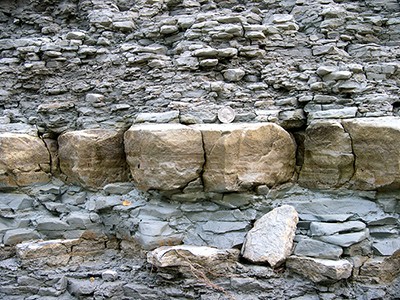
Geologic History of Southwestern Ohio
Fossil Content of Local Limestone
The fossil content of local limestone shows the diversity of life in the late Ordovician period.
Bryozoans and brachiopods, nearly equal in abundance, form about 60% of the allochems in local limestone.
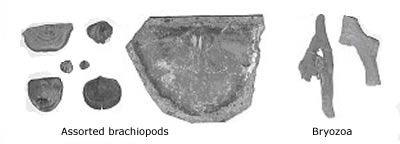
Crinoids form about 20% and trilobitesnearly 10% of the allochems.

According to detailed studies by Martin* (1975), brachiopods and trilobites decrease appreciably in abundance upward in the Cincinnatian Series. In contrast, algae, ostrocodes, and corals, which are uncommon throughout most of the sequence, are very common in the upper part. Dolomite forms less than 1% of the limestones of the lower part of the sequence, but more than 5% of those in the upper part.
Photomicrographs of local limestone samples below showing fossil fragments (Bc=brachiopod, Br=bryozoan, O=ostracode, T=trilobite) and matrix (M=microspar, P=pseudospar). Both intact and fragmented, but recognizable shells and skeletons are known as allochems. Finer-grained mud-sized particles initially lithify to micrite and can later recrystallize to microspar or pseudospar. Adapted from Martin, 1975.

*Martin, W.D., 1975. The petrology of a composite vertical section of the Cincinnatian Series limestones (Upper Ordovician) of southwestern Ohio, southeastern Indiana, and northern KentuckyJour. Sed. Petrology, v 45, no. 4, pp. 907 -925.
Life in the Late Ordovician
Four hundred and fifty (450) million years ago, during the Late Ordovician, most of Ohio was under water. At that time, the Oxford, Ohio area was part of a large inland sea that stretched from the Gulf of Mexico to the Arctic. This sea teemed with marine life, its abundance and diversity rivaling modern-day sea life. However, in the Ordovician, the creatures were invertebrates, or organisms lacking a backbone, such as brachiopods, trilobites, and corals.
These organisms were perfectly suited to survive in the warm waters of the ancient ocean and a climate similar to the climate of the Caribbean today.
Why Was It So Warm?
There are 2 reasons:
- Global climate during the Ordovician was generally warmer (compared to the present).
- The area that would later become southwestern Ohio was about 20° south of the equator at that time.
A Great Place to Collect Fossils
Due to the abundance of life in the Ordovician ocean, southwestern Ohio is one of the best Ordovician fossil collecting sites in the world. The great number of fossils shows the nature of life in benthic communities in the Ordovician ocean.
The Cincinnatian Series
The layers of Ohio's bedrock are slightly tilted, with the youngest rocks at or near the surface in the eastern half of the state and the oldest rocks exposed in the west. The oldest rocks, including the beds of southwestern Ohio near Cincinnati, were formed during the Late Ordovician Period. These formations, known as the Cincinnatian Series, are approximately 200 meters (600 feet) thick and are composed of alternating thin to very thin bedded, gray, fossiliferous limestone and blue-gray shale (or mudstone).
Limestone and Shale Layers
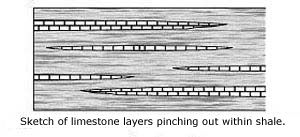 The proportion of shale to limestone varies greatly within the Cincinnatian Series. There are generally larger amounts of shale in the lower and upper parts of the Series. Single limestone beds are not continuous layers across the shale, but generally extend only for a few meters to several tens or hundreds of meters, pinching out within the shale.
The proportion of shale to limestone varies greatly within the Cincinnatian Series. There are generally larger amounts of shale in the lower and upper parts of the Series. Single limestone beds are not continuous layers across the shale, but generally extend only for a few meters to several tens or hundreds of meters, pinching out within the shale.
The Cincinnatian Series is divided into several separate packages or sets of layers, called formations. The Waynesville Formation (or Waynesville Shale) exemplifies the concept of a formation.
Waynesville Formation
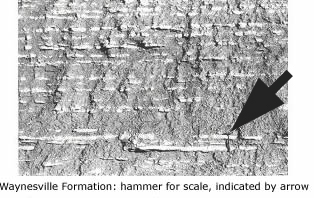 The Waynesville Formation is blue-gray shale (or mudstone) with minor, interbedded thin limestone layers. It contrasts markedly with the overlying Liberty Formation, which has more equal amounts of shale and limestone in its layers.
The Waynesville Formation is blue-gray shale (or mudstone) with minor, interbedded thin limestone layers. It contrasts markedly with the overlying Liberty Formation, which has more equal amounts of shale and limestone in its layers.
The thin limestone layers within the shale, characteristic of the Waynesville Formation, are best seen in fresh exposures like a 'new' roadcut in 1974 (photo at right). Weathering and erosion make it more difficult to see these layers in older roadcuts.
Some important characteristics of local formations, include:
- bedding contacts
- cracks
- ripple marks
Learn more about:
- fossils of the Cincinnatian Series
- sediment formation
Sediment Formation in the Late Ordovician
Limestone is commonly formed from the slow accumulation and lithification of carbonate sediments. In the case of our local rocks, these carbonate sediments accumulated for the most part in and around benthic communities. These communities of organisms developed on the muddy bottom of the warm Ordovician sea.
The shallow ocean environments of the near shore and shore zones, where most of the limestone formed, are often referred to as "carbonate factories." The invertebrate organisms typical of these environments had shells or skeletons made of calcium carbonate, either in the form of the mineral calcite or its polymorph, aragonite.
As the organisms died, some shells and skeletons remained intact, and these remains were added to the coarse and fine particles left by other organisms. The finest-grained portion of these accumulations, generally referred to as carbonate ooze or mud, is thought to have originated from at least 3 different sources:
- fragmentation and disintegration of shells and skeletons or organisms
- small crystals of carbonate minerals produced by calcareous algae, only a few microns in size
- inorganic precipitation directly from seawater
After the sediment accumulated, and additional layers were deposited on top of it, the sediment was compressed and cemented to form solid rock, a process known as lithification.
Cincinnatian Series Limestone
Cincinnatian Series limestone has very distinct characteristics. The most abundant limestone in the Cincinnatian Series is a coarse grained rock with poorly sorted grains consisting of 30% to 40% fossil allochems surrounded by 60% to 70% matrix developed from what was originally carbonate ooze.
The average Cincinnatian limestone is a borderline rock between a partially recrystallized skeletal wackestone (WACK-y stone) and a packstone, but more commonly a wackestone. Wackestone is limestone that consists mostly of hardened ooze with grains supported throughout the stone.
In constrast, packstone has more grains that actually touch each other, forming a self-supporting framework containing hardened ooze only in the pores. The diagrams below show the difference between wackestone and packstone.

Characteristics of Local Bedrock
The bedrock of southwestern Ohio contains certain characteristics that can tell you a lot about the environment in which the sediments that later became our local bedrock were deposited; these characteristics include:
- bedding contacts
- desiccation cracks
- ripple marks
Bedding Contacts
Bedding contacts are the boundaries between adjacent beds of sedimentary materials representing changes in the nature of sediments over time. An example of a bedding contact is the surface separating a sandstone layer from an overlying shale layer. Bedding contacts can be gradational (gradual) or sharp (abrupt). As such, bedding contacts tell you how quickly the layers formed.
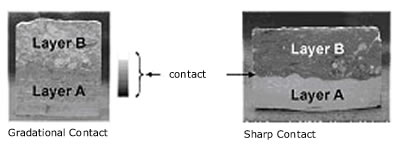
If the contact is not very well defined and appears gradational, that means that sediments were deposited gradually. This type of contact reflects the occurrence of gradual changes in a benthic community over time.
If the contact is sharp, that means that there was a rapid change in sediment type. One example of a cause of rapid change is the storms that frequently destroyed benthic communities. These disturbances removed all fine matter, leaving the coarse to settle down. This would later cause a sharp bedding contact.
Most bedding contacts in the Cincinnatian Series are gradational; however, some are sharp and diastemic.
Desiccation Cracks
Desiccation cracks occur in several of the formations. These features are the result of drying of fine-grained sediments due to subaerial exposure in tidal flats. Finding mudcracks in a bedrock outcrop tells you that the sediments forming the rocks were very close to sea level after their deposition and before their lithification.
Ripple Marks
Ripple-marked beds occur in all of the formations of southwestern Ohio. These features are the result of the action of waves in relatively shallow water. The presence of ripple marks in a sedimentary layer tells geologists that the sediments in that layer were deposited within the reach of waves, within a few feet or tens of feet from the water's surface.